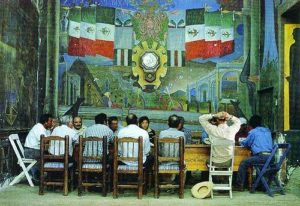
Communication is more than just speaking, writing, and editing; it also involves information gathering and teamwork.
In the economy of the new century, this means communicating cross-culturally. There are three main components to any communication:
- subject matter
- medium of delivery
- cultural considerations
Of the three, the third is generally ignored. While fashionable phrases get uttered – mostly, celebrating cultural diversity, what results are mostly exercises in politically correct language — or attempts at controlling personal irritation. (Few people seem to feel the need to truly face the underlying issues that cloud even the simplest of delicate, and frequently confusing, cross-cultural interactions.)
ICEBERGS
Culture? People have characterized the idea to death. For our purposes let’s define culture as the way in which each of us is programmed to behave in the environment.
Cultures are like icebergs; some features are apparent to anyone not in a fog, while others are deeply hidden. Above-the-surface features include overt behaviors: how people –
- dress
- eat
- walk
- talk
- relate to one another
- conduct themselves during public ceremonies such as weddings or funerals
Also included are such things as social distance.
Other aspects are so far below the surface that they are hard to recognize. We may see evidence of these aspects, but we usually cannot pinpoint them precisely and usually do not have a clue where they came from.
They are hard to define even for our own culture because we take them in with our mother’s language.
This might include such things as:
- how we encode and retrieve information
- What is justice?
- Music?
- Proper parenting?
- Beauty or ugliness?
- What meaning is attached to “teaching” stories?
- What does being well-educated mean?
- What constitutes status?
CONVERGENCE AND DIVERGENCE
Global communication, transportation, and changes in living styles have begun to blur many of the surface distinctions between different cultures.
Many cultures are adopting Western dress, for example.
The deeper differences remain. For example, compare the respect due to elders in some Asian, Latin, and African societies–still true today even in modern urban environments–with the way seniors are viewed in many Western countries.
While there is some surface convergence, there is divergence as well. In fact, the world seems to become more tribal as opportunities for communication expand.
As the idea of a unified Europe becomes a reality, for example, many people are exerting their differences more, not less. Or, witness the ethnic strife and new nation-states that have emerged with the dissolution of the Soviet Union.
Cross-cultural communication is more important now than it has ever been. How can this idea be put to practical use?
HIGH- AND LOW-CONTEXT CULTURES
One of the deep or hidden aspects that differentiate cultures is the amount of context a culture’s members expect in social interactions. People who study such things divide cultures into those, which are high context, and those which are low context.
In general, high context cultures place great importance on:
- ambience
- decorum
- the relative status of the participants in a communication
- the manner of a message’s delivery.
Low context cultures tend to want to ignore such things and emphasize the content of a communication, an attitude that might be expressed in the phrase “cut to the chase.”
Example:
Imagine a business environment; several team members have been gathered from around the world to attend a corporate meeting.
At this meeting they are expected to make key decisions that will affect corporate goals and objectives. Included on the new team are people from –
- Korea
- Malaysia
- Singapore
- South Africa
- Mexico
- Chile
- Germany
- Denmark
- Canada
This is the first full face-to-face meeting of the entire team. They are all gathered in the foyer outside the conference room of the Seoul office.
Formal introductions are made during this preliminary meeting while the team members breakfast on coffee, tea, and pastries.
After a while, they all move into the conference room. The tables and chairs are arranged facing the front of the room in traditional classroom style.
The Canadians, the Germans, and the Danes look rather unhappy, and with a few disapproving words about this making for poor interaction, begin rearranging the furniture. The host Koreans look confused and make no comments. Neither do the other Asians or those from Latin America.
The meeting begins; the agenda is announced; issues are raised, discussed, and decided upon.
At the end of the morning session, the Germans comment to the Danes that the Koreans, Chileans, Mexicans, and Malays have not said much. The Canadians and the Danes nod in agreement, and shrug.
After lunch, the Koreans host a Malay and a Mexican colleague takes the Canadian team leader aside and expresses very strong reservations about one of the decisions.
The Canadian is aghast; the morning meeting has been wasted; the discussion will have to begin again. “Why didn’t you say so during the meeting?” he fairly shouts.
WHAT HAPPENED?
For the Asians and Latin Americans, members of high-context societies:
- issues
- circumstances
- relationships
are as important as the work. In this case the business being discussed at the meeting. Interpersonal relationships were not developed well enough in this fledgling team for the objection to an argument to be raised publicly.
Also, team members with higher status in the organization were present. The cultural orientation of those from High Context societies insisted that comments be made at a more private (appropriate) time. The context of where and how comments and opinions are heard was, clearly, more important to them than the comments themselves.
The others, coming from low-context cultures, just wanted to get the job done.
The furniture was rearranged because they were interested in the task and in getting it accomplished as efficiently as possible.
The Asians and Latin Americans wanted to spend some time learning about each other and establishing a foundation for relationships. The classroom atmosphere and the brief opportunities for socializing were, in fact, exactly what they needed in this new setting.
A VERY EXPENSIVE MISTAKE.
The per diem cost of gathering people from all over the world could easily reach tens of thousands of U.S. dollars.
The best that can be hoped for in this kind of a multicultural team situation is an environment that fosters the building of a shared culture — a context, mutually agreed upon – wherein this “virtual” culture can grow, thrive, and benefit from the cultural richness of individual members.
THE CHALLENGE
So, let’s take a look at this: people, programmed differently and with little, or at best, a superficial knowledge of each other, now have to communicate something in such a way as to make meaning clear and not provoke misunderstanding.
The message might be anything from a simple sales pitch (“buy my widgets”) to an attempt by a global corporate leader to communicate a vision to employees in fifty countries.
The communicator wants a particular and sometimes well defined reaction to the message. The challenge is to get the desired reaction from the communication.
It is sometimes very difficult to do so.
BUILDING UNDERSTANDING
Understand the cultures you are attempting to communicate with.
Begin by looking for rich points such as those found in a culture’s rituals. Rich points provide a web of associations. By analogy they may give you insights into the culture.
WHAT DOES THIS MEAN?
Reading rich points is similar to learning a new language. You’re traveling and you notice such things as food, articles of clothing, etc., that are different, yet similar to things in your own culture. Your language skills say: replace this old word with this new one. (A serape is a blanket that is worn like a coat.)
Eventually you acquire a simple vocabulary in the new language. Similarly, you are somewhat familiar with various rites and rituals–weddings, funerals, rites of passage–that occur in every culture. Your cultural skills say: replace this idea with that one.
Eventually, you begin to understand (superficially and overtly) the new cultural environment.
A web of understanding begins to develop based on prior experiences.
Sometimes, the language and cultural cues are such that you have no experience with the situation or any clues at all. It is nearly impossible to develop a “web” in such a situation. At such times you need a cultural guide, someone to provide you with the clues you will need–to develop understanding.
COMMON DENOMINATORS
Know your audience(s) well enough to be able to anticipate their reaction to your communication. It is impossible to learn all the cultures you must communicate with, especially if you are developing something for export to many countries. The best you can do is try to find a common denominator and work from there.
SUCCESS STORY
One successful example is the Macintosh GUI interface with its folders and trash cans. Its use of icons and simple concepts satisfies the communication needs of most people. Have you known anyone who experienced serious difficulty figuring it out on a MAC?
Some people are such sophisticated users that the loss of control over the details of the system irritates them; others are confused by the icons on the screen and need additional help. And, most people looking at the interface can intuit what to do. This works regardless of language.
The lesson: giving most of your audience access to your material is not really impossible; doing so takes creativity and imagination.
CONCLUSION
Remember, above all: reality is only an opinion–yours and everyone else’s. Your special reality is formed in the cultural environment in which you were born, raised, and spent most of your life.
Your reality will never completely match someone else’s. Find commonality, and work from there. Look for rich points and try to understand and use them. Create webs.
With hard work, and luck, you will find common denominators and achieve a high factor of mutuality in your cross-cultural communications.

